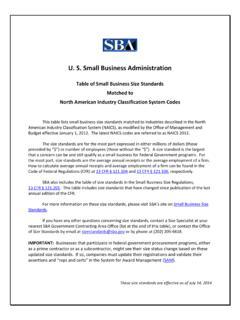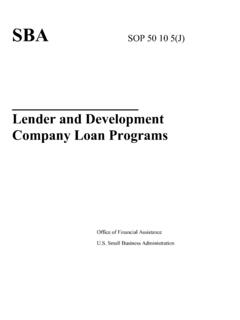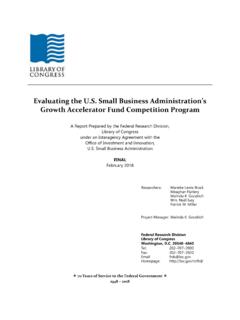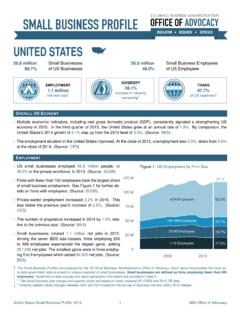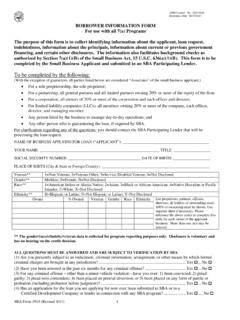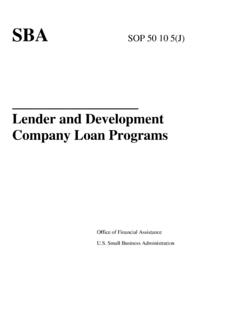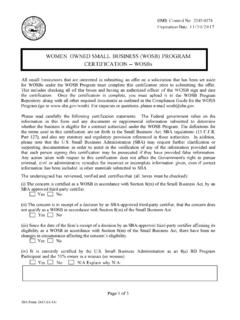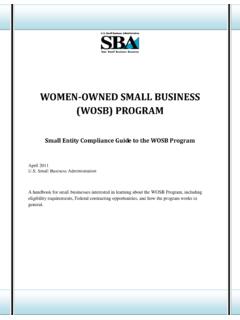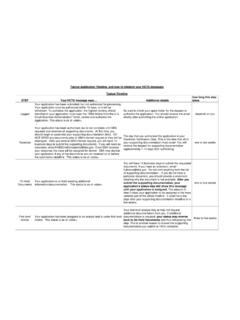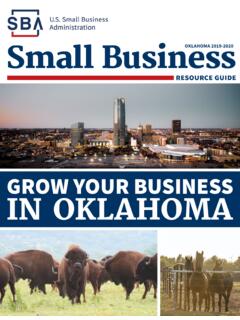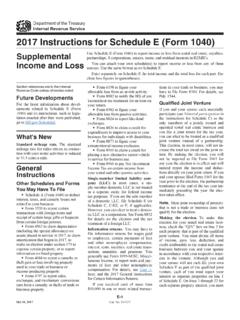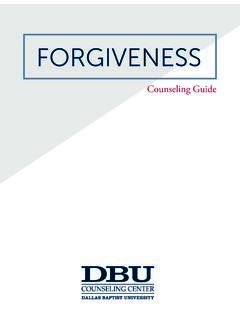Transcription of PAYCHECK PROTECTION PROGRAM - Small Business …
1 As of October 13, 2020 1 PAYCHECK PROTECTION PROGRAM Frequently Asked Questions (FAQs) on PPP Loan forgiveness The Small Business Administration (SBA), in consultation with the Department of the Treasury, is providing this guidance to address borrower and lender questions concerning forgiveness of PAYCHECK PROTECTION PROGRAM (PPP) loans, as provided for under section 1106 of the Coronavirus Aid, Relief, and Economic Security Act (CARES Act), as amended by the PAYCHECK PROTECTION PROGRAM Flexibility Act (Flexibility Act). Borrowers and lenders may rely on the guidance provided in this document as SBA s interpretation, in consultation with the Department of the Treasury, of the CARES Act, the Flexibility Act, and the PAYCHECK PROTECTION PROGRAM Interim Final Rules ( PPP Interim Final Rules ) (link).
2 General Loan forgiveness FAQs 1. Question: Which l oan forgiveness application should sole proprietors, independent contractors, or self -employed individuals with no employees complete? Answer: Sole proprietors, independent contractors, and self -employed individuals who had no employees at the time of the PPP loan application and did not include any employee salaries in the computation of average monthly payroll in the Borrower Application Form automatically qualify to use the Loan forgiveness Application Form 3508EZ or lender equivalent and should complete that application. 2. Question: Can PPP lenders use scanned copies of documents, E-signatures, or E-consents for loan forgiveness applications and loan forgiveness documentation?
3 Answer: Yes. All PPP lenders may accept scanned copies of signed loan forgiveness applications and documents containing the information and certifications required by SBA Form 3508, 3508EZ, or lender equivalent. Lenders may accept any form of E-consent or E-signature that complies with the requirements of the Electronic Signatures in Global and National Commerce Act ( 106-229). If electronic signatures are not feasible, then when obtaining a wet ink signature without in-person contact, lenders should take appropriate steps to ensure the proper party has executed the document. This guidance does not supersede signature requirements imposed by other applicable law, including by the lender s primary federal regulator.
4 3. Question: If a borrower submits a timely loan forgiveness application, does the borrower have to make any payments on its loan prior to SBA remitting the forgiveness amount, if any? Answer: As long as a borrower submits its loan forgiveness application within ten months of the completion of the Covered Period (as defined below), the borrower is not As of October 13, 2020 2 required to make any payments until the forgiveness amount is remitted to the lender by SBA. If the loan is fully forgiven, the borrower is not responsible for any payments. If only a portion of the loan is forgiven, or if the forgiveness application is denied, any remaining balance due on the loan must be repaid by the borrower on or before the maturity date of the loan.
5 Interest accrues during the time between the disbursement of the loan and SBA remittance of the forgiveness amount. The borrower is responsible for paying the accrued interest on any amount of the loan that is not forgiven. The lender is responsible for notifying the borrower of remittance by SBA of the loan forgiveness amount (or that SBA determined that no amount of the loan is eligible for forgiveness ) and the date on which the borrower s first payment is due, if applicable. 4. Question: The PPP loan forgiveness application forms (3508, 3508EZ, and 3508S) display an expiration date of 10/31/2020 in the upper-right corner. Is October 31, 2020 the deadline for borrowers to apply for forgiveness ?
6 Answer: No. Borrowers may submit a loan forgiveness application any time before the maturity date of the loan, which is either two or five years from loan origination. However, if a borrower does not apply for loan forgiveness within 10 months after the last day of the borrower s loan forgiveness covered period, loan payments are no longer deferred and the borrower must begin making payments on the loan. For example, a borrower whose covered period ends on October 30, 2020 has until August 30, 2021 to apply for forgiveness before loan repayment begins. The expiration date in the upper-right corner of the posted PPP loan forgiveness application forms is displayed for purposes of SBA s compliance with the Paperwork Reduction Act, and reflects the temporary expiration date for approved use of the forms.
7 This date will be extended, and when approved, the same forms with the new expiration date will be Loan forgiveness Payroll Costs FAQs 1. Question: Are payroll costs that were incurred during the Covered Period2 or the Alternative Payroll Covered Period3 but paid after the Covered Period or the Alternative Payroll Covered Period eligible for loan forgiveness ? 1 All questions and answers published August 4, 2020 unless specified otherwise. General Loan forgiveness FAQ 4 published October 13, 2020. 2 The Covered Period is either (1) the 24-week (168-day) period beginning on the PPP loan disbursement date, or (2) if the borrower received its PPP loan before June 5, 2020, the borrower may elect to use an eight-week (56-day) Covered Period.
8 For example, if the borrower is using a 24-week Covered Period and received its PPP loan proceeds on Monday, April 20, the first day of the Covered Period is April 20 and the last day of the Covered Period is Sunday, October 4. In no event may the Covered Period extend beyond December 31, 2020. 3 Borrowers with a biweekly (or more frequent) payroll schedule may elect to calculate eligible payroll costs using the 24-week (168-day) period (or for loans received before June 5, 2020 at the election of the borrower, the eight-week (56-day) period) that begins on the first day of their first pay period following their PPP loan disbursement date ( , the Alternative Covered Period ).
9 For example, if the borrower is using a 24-week Alternative Payroll Covered Period and received its PPP loan proceeds on Monday, April 20, and the first day of its first pay period As of October 13, 2020 3 Answer: Yes, if the payroll costs are paid on or before the next regular payroll date after the Covered Period or Alternative Payroll Covered Period. Example: A borrower received its loan before June 5, 2020 and elects to use a 24-week Covered Period. The borrower s Covered Period runs from Monday, April 20 through Sunday, October 4. The borrower has a biweekly payroll cycle, with a pay period ending on Sunday, October 4. However, the borrower will not make the corresponding payroll payment until the next regular payroll date of Friday, October 9.
10 Under these circumstances, the borrower incurred payroll costs during the Covered Period and may seek loan forgiveness for the payroll costs paid on October 9 because the cost was incurred during the Covered Period and payment was made on the first regular payroll date after the Covered Period. 2. Question: Are payroll costs that were incurred before the Covered Period but paid during the Covered Period eligible for loan forgiveness ? Answer: Yes. Example: A borrower received its loan before June 5, 2020 and elects to use a 24-week Covered Period. The borrower s Covered Period runs from Monday, April 20 through Sunday, October 4. The borrower has a biweekly payroll cycle, with a payroll cycle ending on Saturday, April 18.
